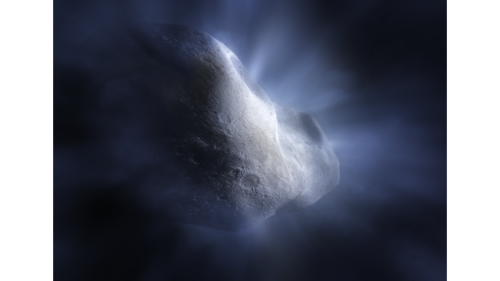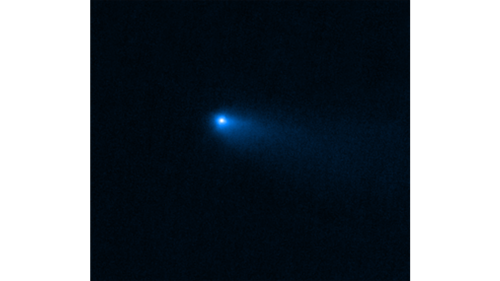In a major scientific breakthrough, NASA's James Webb Space Telescope has found water in a comet in the main asteroid belt. The comet, named 238P/Read, is located between Mars and Jupiter. It is the first comet to be found in the main asteroid belt, and its discovery has raised new questions about the origins of water in our solar system.
The team of astronomers who made the discovery used Webb's NIRSpec (Near-Infrared Spectrograph) instrument to study the comet's spectrum. They found clear evidence of water vapor in the comet's atmosphere. This is the first time that water has been detected in a comet in the main asteroid belt.
The discovery of water in 238P/Read is significant because it suggests that water ice may be more widespread in the solar system than previously thought. It also raises new questions about how water came to be in the main asteroid belt. One possibility is that water ice was brought to the main asteroid belt by comets that were captured from the outer solar system. Another possibility is that water ice was formed in the main asteroid belt itself, from the collision of asteroids and comets.
The discovery of water in 238P/Read is a major scientific breakthrough, and it is sure to lead to new insights into the origins of water in our solar system.


| Data | Value |
|---|---|
| Telescope | James Webb Space Telescope |
| Comet | 238P/Read |
| Location | Main asteroid belt |
| Discovery date | May 11, 2023 |
| Method | NIRSpec (Near-Infrared Spectrograph) instrument |
| Significance | First detection of water in a comet in the main asteroid belt |
| Implications | Suggests that water ice may be more widespread in the solar system than previously thought |
| Open questions | How did water come to be in the main asteroid belt? |
Summary:
- NASA's James Webb Space Telescope has found water in a comet in the main asteroid belt.
- The comet, named 238P/Read, is located between Mars and Jupiter.
- This is the first time that water has been detected in a comet in the main asteroid belt.
- The discovery of water in 238P/Read is significant because it suggests that water ice may be more widespread in the solar system than previously thought.
- It also raises new questions about how water came to be in the main asteroid belt.
- One possibility is that water ice was brought to the main asteroid belt by comets that were captured from the outer solar system.
- Another possibility is that water ice was formed in the main asteroid belt itself, from the collision of asteroids and comets.
NASA's Webb Finds Water, and a New Mystery, in Rare Main Belt Comet
NASA's James Webb Space Telescope has made another major discovery, this time finding water in a comet in the main asteroid belt. The comet, named 238P/Read, is located between Mars and Jupiter. It is the first comet to be found in the main asteroid belt, and its discovery has raised new questions about the origins of water in our solar system.
The team of astronomers who made the discovery used Webb's NIRSpec (Near-Infrared Spectrograph) instrument to study the comet's spectrum. They found clear evidence of water vapor in the comet's atmosphere. This is the first time that water has been detected in a comet in the main asteroid belt.
The discovery of water in 238P/Read is significant because it suggests that water ice may be more widespread in the solar system than previously thought. It also raises new questions about how water came to be in the main asteroid belt. One possibility is that water ice was brought to the main asteroid belt by comets that were captured from the outer solar system. Another possibility is that water ice was formed in the main asteroid belt itself, from the collision of asteroids and comets.
The discovery of water in 238P/Read is a major scientific breakthrough, and it is sure to lead to new insights into the origins of water in our solar system.
What is a main belt comet?
Main belt comets are a type of comet that is found in the main asteroid belt between Mars and Jupiter. They are thought to be made up of the same material as asteroids, but they also contain water ice. When main belt comets get close to the sun, the heat from the sun causes the water ice to sublimate, or turn directly from a solid to a gas. This releases gas and dust into the comet's atmosphere, creating a coma, or a cloud of gas and dust. The coma can be millions of kilometers wide, and it is what makes main belt comets visible from Earth.
How did Webb find water in 238P/Read?
The team of astronomers who made the discovery used Webb's NIRSpec instrument to study the spectrum of 238P/Read. The spectrum is a plot of the amount of light that is emitted by an object at different wavelengths. By studying the spectrum, astronomers can learn about the composition of an object.
The spectrum of 238P/Read showed clear evidence of water vapor. The water vapor was detected in the infrared part of the spectrum, which is where water vapor emits light. The amount of water vapor that was detected is consistent with the amount of water ice that is thought to be present in main belt comets.
What does the discovery of water in 238P/Read mean?
The discovery of water in 238P/Read is significant because it suggests that water ice may be more widespread in the solar system than previously thought. It also raises new questions about how water came to be in the main asteroid belt.
One possibility is that water ice was brought to the main asteroid belt by comets that were captured from the outer solar system. The outer solar system is home to many comets, and it is thought that these comets were formed in the same region as the planets. When these comets were captured by the gravity of the sun, they were pulled into the main asteroid belt.
Another possibility is that water ice was formed in the main asteroid belt itself. The main asteroid belt is thought to be made up of the remains of a planet that was destroyed early in the history of the solar system. When this planet was destroyed, its water ice was released into the main asteroid belt.
The discovery of water in 238P/Read is a major scientific breakthrough, and it is sure to lead to new insights into the origins of water in our solar system.
Referenced:
Credits: NASA, ESA, CSA, and J. Olmsted (STScI)
Images: webbtelescope.org
Discover More
Most Viewed
Christmas is a season of joy, love, and traditions. And what better way to get into the holiday spirit than through timeless carols? These musical gems have been bringing people together for generations. Here’s our ranked list of the Top 10 Christmas Caro…
Read More
















